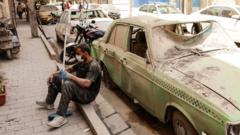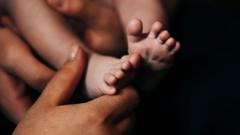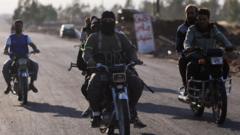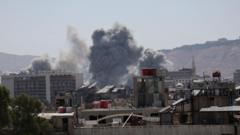As Tehran begins to regain its vibrancy after a series of devastating attacks, the citizens are caught between a longing for peace and the harsh realities of ongoing unrest.
**Tehran's Resilience Amidst Turmoil: A City at the Crossroads**

**Tehran's Resilience Amidst Turmoil: A City at the Crossroads**
Amid rising tensions and conflict, Tehran's residents strive for normalcy, reflecting a city grappling with its uncertain future.
In the heart of Tehran, life is cautiously resuming at the Boof cafe, nestled within the once-mighty US embassy grounds now draped with anti-American murals. A barista named Amir expresses hope for improved relations with the US, lamenting the hardships brought by enduring sanctions. The contrasting clientele of the cafe symbolizes the divided culture, where traditional norms clash with modern freedoms – a woman in a black veil sits alongside another in casual attire, silently voicing the myriad of identities present in the city.
Just a short distance away, tension grips the air at the IRIB state TV station. A speech by Supreme Leader Ayatollah Ali Khamenei blares across the screens, echoing a long-standing narrative of confrontation with the West. He reinforces the sentiment that the struggle is fundamentally about Iran's resilience against external pressure. The ruins where his address was meant to be broadcast stand as a grim testament to the recent violence, particularly Israel’s recent airstrikes targeting Iranian military infrastructure, fostering an atmosphere of fear and uncertainty among citizens.
Nurse Ashraf Barghi, working in a Tehran hospital, voices a sentiment shared by many: "We are scared of what might come next." Wounded civilians from the strikes are still being treated, and the damage weighs heavily on the community's psyche. Reports indicate scores of casualties, with families mourning the loss of loved ones as life teeters between fear and routine.
Yet, as the city begins to open its doors again, remnants of a bustling metropolis emerge. Roads are filled with traffic, and shopping districts show signs of life, although the scars of recent history remain visible. Young residents, like Mina, share emotional testimonies of heartbreak and uncertainty as they navigate their futures amidst continuous conflict.
At an outdoor concert near the iconic Azadi Tower, the juxtaposition of joy and distress becomes poignant as the performance seeks to soothe a city still on edge. Citizens united by anxiety about the future find moments of reprieve, engaging in conversations about the need for more freedoms while reflecting on the ongoing challenges imposed by the government and external forces.
This intricate dance of resilience and fear defines Tehran today, as residents navigate the complexities of their everyday lives, craving both normalcy and hope amid an environment of discord. The collective defiance and desire for change are evident as citizens await their leaders’ next moves and the broader implications of international dynamics that impact their fates.
Just a short distance away, tension grips the air at the IRIB state TV station. A speech by Supreme Leader Ayatollah Ali Khamenei blares across the screens, echoing a long-standing narrative of confrontation with the West. He reinforces the sentiment that the struggle is fundamentally about Iran's resilience against external pressure. The ruins where his address was meant to be broadcast stand as a grim testament to the recent violence, particularly Israel’s recent airstrikes targeting Iranian military infrastructure, fostering an atmosphere of fear and uncertainty among citizens.
Nurse Ashraf Barghi, working in a Tehran hospital, voices a sentiment shared by many: "We are scared of what might come next." Wounded civilians from the strikes are still being treated, and the damage weighs heavily on the community's psyche. Reports indicate scores of casualties, with families mourning the loss of loved ones as life teeters between fear and routine.
Yet, as the city begins to open its doors again, remnants of a bustling metropolis emerge. Roads are filled with traffic, and shopping districts show signs of life, although the scars of recent history remain visible. Young residents, like Mina, share emotional testimonies of heartbreak and uncertainty as they navigate their futures amidst continuous conflict.
At an outdoor concert near the iconic Azadi Tower, the juxtaposition of joy and distress becomes poignant as the performance seeks to soothe a city still on edge. Citizens united by anxiety about the future find moments of reprieve, engaging in conversations about the need for more freedoms while reflecting on the ongoing challenges imposed by the government and external forces.
This intricate dance of resilience and fear defines Tehran today, as residents navigate the complexities of their everyday lives, craving both normalcy and hope amid an environment of discord. The collective defiance and desire for change are evident as citizens await their leaders’ next moves and the broader implications of international dynamics that impact their fates.


















